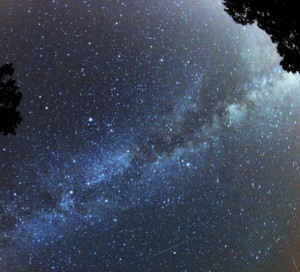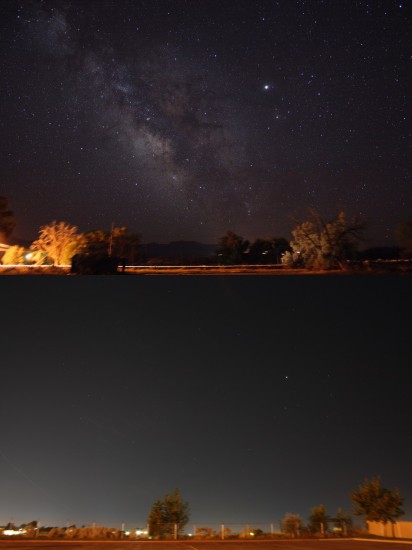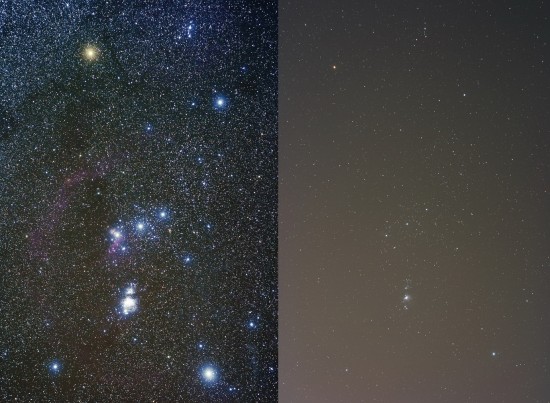 Ever since I was a young boy, I have loved the night sky. A favorite thing was to lie on my back, look up at all the stars and wonder if anyone else was up there, looking back at me. In my mind, I would trace out my own asterisms and give them goofy names.
Ever since I was a young boy, I have loved the night sky. A favorite thing was to lie on my back, look up at all the stars and wonder if anyone else was up there, looking back at me. In my mind, I would trace out my own asterisms and give them goofy names.
I now live in the Pacific Northwest where by and large, we have smog free skies so the seeing should be great! Alas, smog is not the only pollutant that robs us of a heavenly heritage we were born to, namely, the sky. My house is in a wonderful area where the building lots are all about a ½ acre. You would think that with so much space between houses, it would be very dark at night. The problem is, our roads are lined with streetlights that are so bright I can read a magazine in my dining room from the light that just one of them sheds. It’s 80 feet away!
Anyone who knows me is aware of my love for astronomy. About 10 years ago, I built a large telescope. It’s a 12.5” Newtonian Reflector on a Dobsonian mount. Because galaxies, nebulas and star clusters are my main interest, I designed it to excel at lower power, wide angle views. It gets used very infrequently mainly because those pesky street lights interfere with its ability to resolve these faint objects.
But it’s not only people with telescopes that are affected. It’s all of us. Did you know that on a dark night, you can see a galaxy with your naked eye? It’s called Alpha Centauri and it’s easy to spot if you know where to look. I am guessing that most of you have never seen it. Sadly, many of you have never even seen the Milky Way floating high above us gracing the night sky with such beauty as to have been the inspiration of many poets and artists alike.
And it’s not just the stars and galaxies we are missing. Light pollution is depriving us of the darkness to such an extent that it has a significant impact on our circadian rhythms. It’s also affecting eco systems around the planet.
Once a source of wonder–and one half of the entire planet’s natural environment—the star-filled nights of just a few years ago are vanishing in a yellow haze. Human-produced light pollution not only mars our view of the stars; poor lighting threatens astronomy, disrupts ecosystems, affects human circadian rhythms, and wastes energy to the tune of $2.2 billion per year in the U.S. alone. – The International Dark-Sky Association
So just how much are we deprived of? The 2 pictures below speak volumes to what we are missing every single night.
Comparison showing the effects of light pollution on viewing the sky at night.
The southern sky, featuring Sagittarius and Scorpius. Top – Leamington, UT, pop. 217
Bottom – Orem, UT, in a metropolitan area of ~400,000.
I’ve attempted to match sky brightness to how it appeared to my eyes. – Jeremy Stanley
The constellation Orion, imaged at left from dark skies,
and at right from within the Provo/Orem, Utah metropolitan area. – Jeremy Stanley
It doesn’t have to be this way. A large part of this problem can be solved easily by hooding the streetlights so that they reflect the light efficiently where it is needed, not into our bedrooms and backyards. Doing so would dramatically darken our skies and save billions of dollars in wasted energy.
Fortunately, there are organizations that are working hard to change all of this. Founded in 1988, The International Dark-Sky Association is the first organization to call attention to the hazards of light pollution. Since that time, they have made some huge strides forward by working with manufacturers, planners, legislators, and citizens to provide energy efficient options that direct the light where it’s needed, not uselessly up into the sky.
One of my favorite sights is to see the wonder in the eyes of someone observing the magnificence of a dark star filled sky, for the first time. I have met people well into their 40’s who have never really seen it. When they finally do, they are astonished and bewitched by the beauty of the heavens above them.
The good news is, most of us don’t have to go too far to get a great view of the cosmos. A few miles should lead you to a place were there are no lights. When you get there, look up and take it all in. Allow 20 minutes for your eyes to get dark adjusted and you’ll see so much more. Even if you’ve seen it before, it never disappoints and it’s good for the soul! After all, we are made of star dust …
Photo Credits
Light Pollution Comparisons – Creative Commons – Jeremy Stanley
Perseid Meteor Below The Milky Way – Creative Commons – Mila
Feature picture of the Milky Way – Creative Commons – Serge Brunier




During WW2 lights at night were forbidden just about everywhere so in the UK the night skies were awesome, magnificent and just wonderful until the dark shapes of the incoming bombers appeared. Then the glory and wonderment of the night skies ceased and for many, on this planet, it ended for ever.
So many people from many countries, gave their lives during those times, as they are unfortunately still doing, trying to bring peace to this troubled world.
People everywhere on this planet, should be able to look more often to the heavens in sheer amazement night and day, not in fear as so many gallant men and women are still having to do.
All children from all countries, should still be able to look in wonderment and enjoy a peaceful way of life and not cringe in fear of what it may bring down on them from wars.
You have done well to bring the amazing sky to our attention Gil, and thank you for a great article.
Let us all pray for peace everywhere.
Hi mom,
Thanks for your comments 🙂
All I can say to your words is one word, and that word is .. amen!!
I second that, heartily, thanks Son.
I remember a night sky years ago when I was camping in New Mexico. I have never seen so many stars in my life. It is truly awe inspiring.
Hey Carl,
For sure! Camping is usually awesome for that 🙂